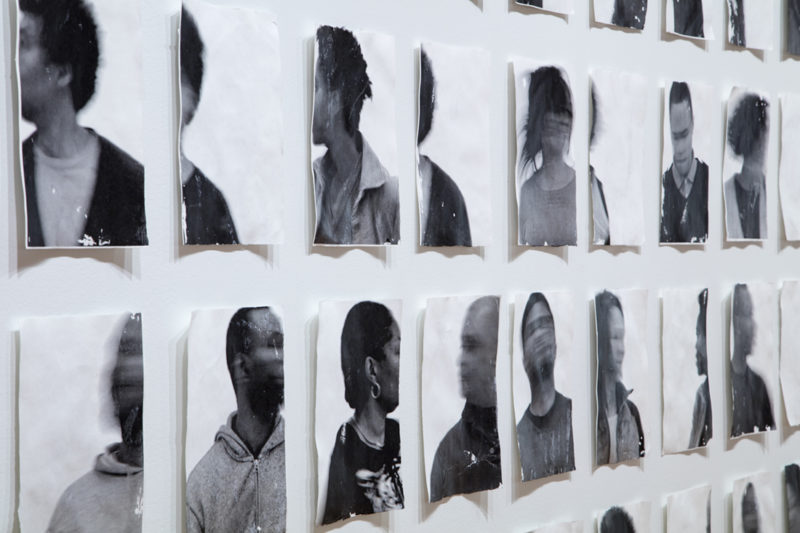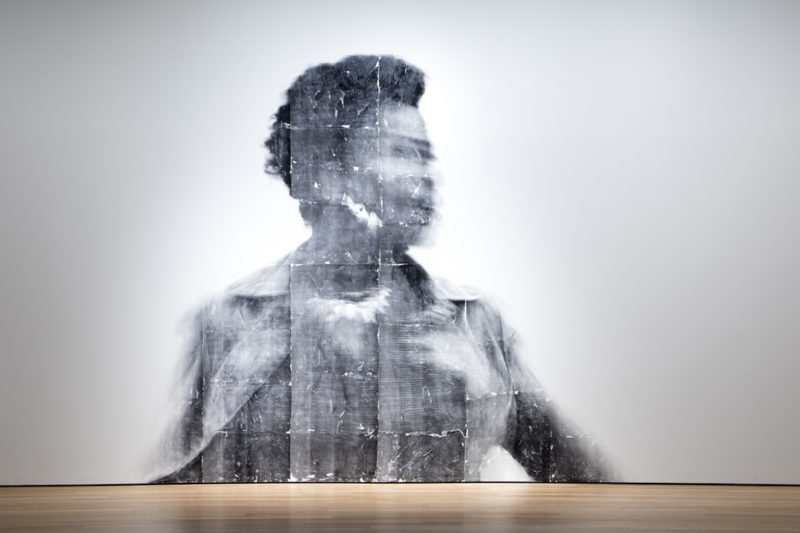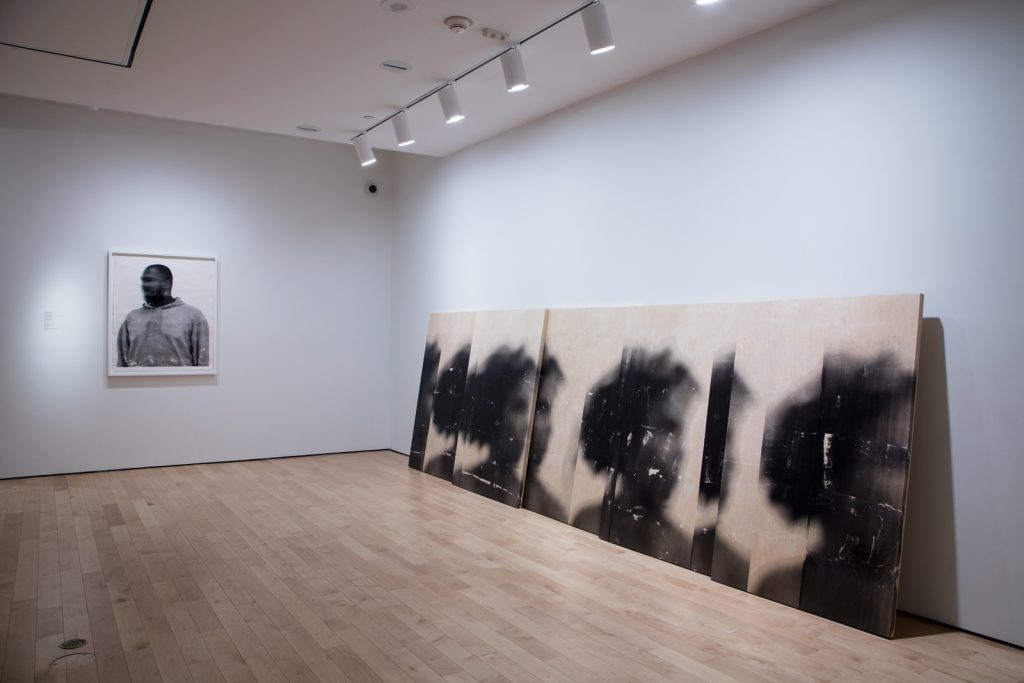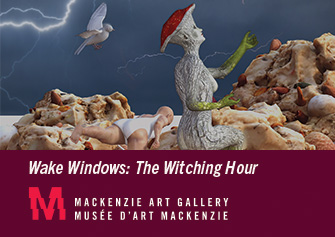Blur at the Art Gallery of Ontario
30 October 2019
By Ricky Varghese
In the Right of Inspection, Jacques Derrida wrote of the medium of photography in these terms: “You could speak of…[a photograph] as of a thinking, as a pensiveness without a voice, whose only voice remains suspended.” I was reminded of this evocative description when I saw Sandra Brewster’s show Blur, on view at the Art Gallery of Ontario from July 24, 2019 to March 29, 2020. The association between Brewster’s work and Derrida’s thinking was brought on by those very final words in the latter’s statement—“…voice [remaining] suspended.” (1) In fact, suspension—or rather what it means to be suspended, to be seen in a seeming state of frozen arrest, both within the frame and, perhaps, beyond it—seems to be an apt way of understanding and talking about the artist’s new work.
There is a suggestive and radical inventiveness to the way in which Brewster suspends her photographs’ subjects. Those familiar with the Guyanese-Canadian artist’s rich oeuvre will quickly discern her continued fascination with the themes of identity, representation, memory, diaspora, and movement. Movement in particular seems to have captured Brewster’s imagination here, especially in how she attempts to represent it. Perhaps it is something that is radically unrepresentable.

What is most striking about this exhibition is witnessing Brewster’s investment in delineating how movement blurs her subjects’ understandings of themselves. Taking fellow Caribbean-Canadians as her subjects for these works, she attends to the varied and complex ways by which diasporic peoples move across time and space—more precisely, across history and geography—to land in the here and now. Brewster is also interested in what it means to move between memory and forgetting, to move between and across the blurred liminal line that cordons off the past from the present.
The blur, which is used as a conceptual framework that governs this series of works, literalizes the possibility of representing her subjects moving across time and space, while also literalizing itself in what Brewster has her subjects perform while she photographs them. She instructs her subjects to move freely as she captures these moments, then transfers the images to new surfaces using a gel medium that “captur[es] the creases and tears and empty spaces where ink does not adhere.” (2)
There is an excitement to this approach, one marked by a measure of uncertainty in what form the final image will take. Brewster suspends this uncertainty quite literally in her approach to photographing her subjects. The blur fastidiously signifies the uneasy nature of migration for immigrants, which Brewster captures in a movingly poetic and adumbrated manner.
In a sense, she precisely rehearses what Derrida had suggested: “[can] we not say that there [is] already in photography…as much production as recording of images, as much act as gaze, as much performative event as archivization?” (3) How, then, does Brewster move between production and recording, between act and gaze, and between performance and archiving in this series?

Creatively uncertain and unpredictable, yet purposeful and inventive in its playfulness, the Blur series opens up the possibility for a discussion about otherness—or what it means to be rendered as other—in the manner by which an immigrant might experience their own difference. The immigrant carries the weight of the histories and memories that they left behind while also feeling the pressures and pleasures of subjective re-invention. The movement depicted in the blur—both in the subjective content and in the technique that was subsequently used to render the images—gives difference and otherness a corporeality. Otherness is not knowable, nor can it be fixed. In the same instance, it resists description—much like the blur—while also demanding to be seen, registered, and recognized. As Gerhard Richter suggests, (4) the “call of the other…can only be staged in multiple voices, and this staging itself can only be written and thought in multiple voices, ones that remain elusive and spectral.” (5) Brewster succeeds at maintaining this elusive and spectral nature of her subjects’ radical otherness—she spiritedly challenges any attempt on the part of the viewer to seek the easy comfort gleaned from reducing her images to mere acts of representation, whether of fixed categories, histories, or identities.
It is not that Brewster invents the other per se, but rather that she allows, or even enables, the other to invent themselves vis-à-vis the site of the photographic medium. What is given to the other is the photograph, and what is given to the photograph is the possibility for its subjects to re-invent themselves; re-inventing as figures that push against any and all fantasies and prejudices formed around them. As Richter reminds us, “is not photography itself a name for the impossible possibility of invention?” (6) Difference, alterity, otherness—all of these emerge from the way in which these figures move in the stillness and erupt, in how movement becomes suspended within and by the image-making process. It is as though the figures utter something in their gestures—a tension within the stillness that cannot be stilled, a voice that, while it remains suspended, cannot be silenced. Brewster thus stands as both witness and archivist to the contours that her blurry subjects produce, and as committed documenter of the experiences that these contours stand for: newness, difference, arrival, departure, and the production of voice for the otherwise voiceless.
1. Derrida, Jacques. Right of Inspection. Translated by David Wills. New York: The Monaccelli Press, 1999. ix.
2. Quoted from the “Exhibition Overview” on the AGO webpage for Blur: https://ago.ca/exhibitions/sandra-brewster-blur
3. Derrida, Jacques. Copy, Archive, Signature: A Conversation on Photography. Translated by Jeff Fort. Edited by Gerhard Richter. Stanford, CA: Stanford University Press, 2010. 6.
4. Here I am referring to Gerhard Richter, the Stanford University professor of German and Comparative Literature and not the German abstract and photo-realist painter Gerhard Richter.
5. Richter, Gerhard. “Between Translation and Invention: The Photograph of Deconstruction. In Copy, Archive, Signature: A Conversation on Photography, edited by Gerhard Richter. Stanford, CA: Stanford University Press, 2010. xxxvii.
6. Ibid.
Blur ran from July 24, 2019 – March 29, 2020 at the Art Gallery of Ontario in Toronto, ON.
Feature image: (From left to right) Blur 21, 2017 and Untitled, 2015 – 2016 by Sandra Brewster. All photos courtesy of the AGO.



